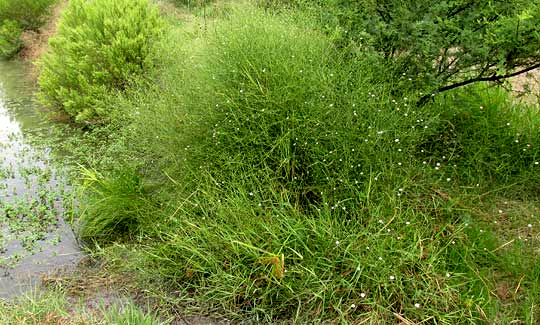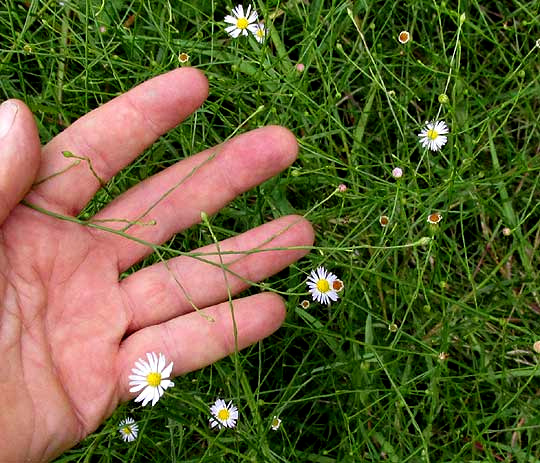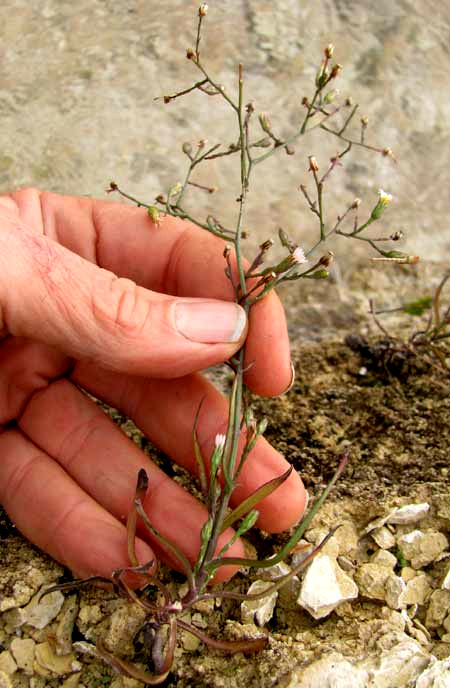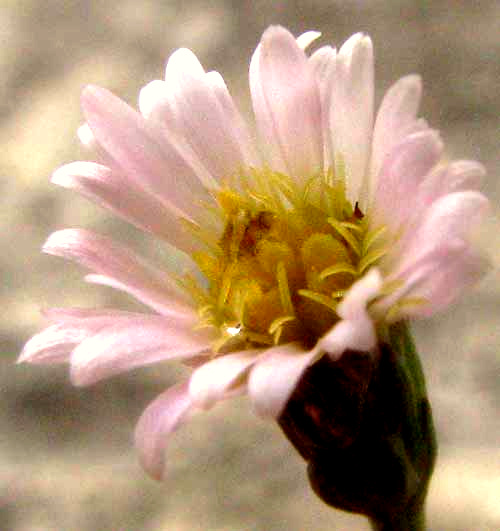Excerpts from Jim Conrad's
Naturalist Newsletter
from the October 5, 2014 Newsletter issued from the Frio Canyon Nature Education Center in the valley of the Dry Frio River in northern Uvalde County, southwestern Texas, on the southern border of the Edwards Plateau; elevation ~1750m (~5750 ft); N29.62°, W99.86°; USA
SALTMARSH ASTER, A BIG ONE
In mud beside one of the treatment ponds around which Cook's Slough Nature Park on Uvalde's south side is organized, a five-ft-tall (1.5m) mound of much branching, very slender stems and leaves gave the impression of being dense and impenetrable at its center, but so diffuse and airy at its surface that at a distance its tiny, white flowering heads seemed to hover around the plant without being connected to it. Below, you can see the effect:

Up close, the flowering heads turn out to be of a classically aster type, though a bit on the smallish size. By aster-type is meant that the plant is of the Composite or Daisy Family, with flowering heads consisting of tiny, cylindrical, normally yellow disc flowers forming the head's "eye," and with many slender, normally white ray flowers radiating away from the eye. This plant's aster-type heads arose at the tips of remarkably long, slender, stiff-looking stems, or peduncles, as shown below:

A close-up of an "eye" consisting of only a few cylindrical disc flowers, with outside ones open -- each with regulation five, pointy corolla lobes -- while the center ones are still closed, appears below:

Seeing this plant, my first thought was that it was the largest, most vigorous-looking aster I'd seen in my whole life. I couldn't wait to identify it and see how rare and/or unusual it really was. Knowing that a huge number of aster species exist and that sometimes they can be hard to identify, I made sure to get a photo of the green, scaly, cup-like "involucre" from which the disc and ray flowers emerge, as seen below:

Notice that this involucre's scales, or "phyllaries," are sharp-pointed with pale, cellophane-like (hyaline) edges, and that they're completely hairless (glabrous).
These and other features led me to an aster species that since my school days has been kicked into a genus other than aster, because someone broke the big, beautiful, easy-to-recognize genus Aster into several smaller, hard-to-remember ones. Our plant used to be Aster subulatus, but now it's SYMPHYOTRICHUM SUBULATUM, variously known as the Annual Saltmarsh Aster, Eastern Annual Saltmarsh Aster, Baby's Breath Aster, Bushy Starwort and other names. One reason it bears so many English names is that it's widespread, from South America north through Central America, Mexico and the Caribbean area, through all of the US except for the northwestern and north-central states, and into southern Canada. It's also escaped extensively on other continents.
Moreover, I've documented this species before, found growing from a fissure in a limestone rock at water's edge beside the Dry Frio, in mid December. You can see that eight-inch-tall (20cm), frost-bitten form in the next section.
How amazing that at the end of a growing season such a modest little being might in other summers and conditions soar head high! But note that the flowering heads and flowers of the dwarf and giant plants are exactly the same. That's how wildflowers normally are: The vegetative parts can vary wildly in shape and size, but the flowers and fruits typically remain amazingly uniform no matter what the plants' size and shape.
We can imagine how many tiny, cypsela-type fruits the prodigious numbers of flowers on our giant Cook's Slough plant produces, and that certain small, seed-eating birds might relish pecking at them. Livestock also eat the Saltmarsh Aster's herbage when nothing tastier is handy. The species is even capable of invading moist lawns where when mowed it assumes a leafy, ground-hugging form.
This mud-loving plant's toughness is to be admired. Its robustness is good to see. It's worth knowing.
By the way, according to the new way of thinking about the grand old genus Aster, members of the genus Aster are perennials, but members of the new genus Symphotrichum, to which our Saltmarsh Aster belong, are annuals. Thus our giant Aster at Cook's Slough did all that growing during our current growing season.

from the December 15, 2013 Newsletter issued from the Frio Canyon Nature Education Center in the valley of the Dry Frio River in northern Uvalde County, southwestern Texas, on the southern border of the Edwards Plateau; elevation ~1750m (~5750 ft); N29.62°, W99.86°; USA
SALTMARSH ASTER
Despite several hard freezes during the last couple of weeks, a certain modest little foot-tall member of the Composite, Sunflower or Daisy Family still is flowering in protected spots close enough to the Dry Frio River to benefit from the water's usually-warmer-than-air temperature. Above, you can see this wildflower rooted in a limestone outcrop beside a little waterfall, appearing in the background. A nearby individual better showing the plant's small size, the oversized inflorescence and the narrow leaves appears below:

A peep into the composite flowering head, showing yellow disk flowers with their wishbone-shaped style arms exserted, and faintly pinkish white rays, is shown below:

Looking below the head, below we see that the green phyllaries are slender, with the outer or lower ones being much shorter than the inner ones, and ending in sharp points:

In the old days back in Kentucky, without hesitation I would have called this one of over 600 species of the genus Aster, and I would have known that figuring out which Aster species it was probably would be a struggle. However, during the 1990s gene sequencers split the wonderful old genus Aster into several genera with hard-to-remember, usually long names.
Happily, the Composite Family is finished in the online Flora of North America, so identification keys there direct us to the new genera and then to the species. Using features mentioned above, plus the fact that our plants were annuals -- a large percentage of asters are perennials -- and other field marks, our riverside plants reveal themselves as SYMPHYOTRICHUM SUBULATUM, often referred to as the Annual Salt-marsh Aster. Here we're far from any salt marshes, but that's how it is with common names. The species is widely distributed through the warmer and hotter parts of North, Central and South America, the Caribbean and Mexico; in the US it's mostly confined to the southern tier of states. In the old Aster days it was named Aster subulatus.
The "subulatum" and "subulatus" in the binomials relates to the adjective "subulate," which means "tapering to a point," as do the heads' sharp-pointed phyllaries as well as the leaves. These terms are based on the Latin "subula," meaning "awl."